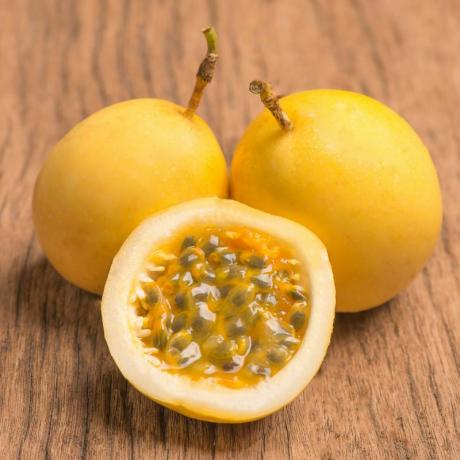
The most common passion fruit here in Brazil is the round passion fruit, with a yellow color. However, there are also several other types of passion fruit with completely different colors, formats and nutritional characteristics. If you've ever watched cooking shows like “The Great British Baking Show”, “Cupcake Wars” or even even “Iron Chef”, you have certainly heard about another type of passion fruit that was very successful for there. Keep reading and learn about 3 different types of fruit.
Read more: Banana passion fruit: what is this food and why is it illegal in some places?
see more
Astrology and genius: THESE are the 4 most brilliant signs of…
iPhones that didn't succeed: 5 launches rejected by the public!
Below are some options of the fruit and its characteristics.
Yellow passion fruit / Passiflora edulis

This is the most common type of passion fruit for Brazilians, it is the one that is present in the daily lives of many people. This type is also the best known in the world and the best known passion fruit variation of all types.
It usually has a round shape and a very yellow color, its flavor is marked by being sour, which is why it is used in several recipes such as: Juices, ice cream, mousses, syrups and jellies. It also has several nutritional characteristics, they are: Having a calming effect, being rich in antioxidants, vitamin A and fibers, in addition to also having plenty of minerals such as calcium, iron and magnesium.
It is cultivated throughout Brazil, with emphasis on the states of Bahia, Santa Catarina, Ceará, São Paulo and Minas Gerais.
Purple passion fruit / passion fruit from the Passiflora vine

This type is best known for the color of its bark, which draws a lot of attention for being purple or yellow resistant and soft entrails full of seeds, is also very well known, because in the last decade he appeared a lot in programs of cooking. It is a smaller variation of the passion fruit we know and is also less acidic than the yellow passion fruit.
Its rind is usually very bitter, but the flesh is sweet and juicy and marked by a tropical flavor. It is widely used to make pulps to mix in cocktails, desserts, salads or even to eat for breakfast. It is a fruit very similar to the pomegranate, due to its gelatinous texture studded with crunchy seeds.
It also has several nutritional characteristics such as: Being an excellent source of vitamin C, iron, calcium and potassium, in addition to having a large amount of fiber and having an antioxidant action.
This type of passion fruit is very popular in European countries, but it is usually grown in places with a subtropical climate, such as in southern Brazil.
passion fruit

This is the largest variation of all passion fruit types and is also known as giant grenadillo, grenadine or badea. It can reach up to 3 kg and is known for having a greenish-yellow skin and a sweeter taste.
It can be found mainly in the North region of Brazil, but it is not as common as other types of passion fruit here in Brazil. However, like the others, it also has several important nutritional characteristics such as: Having a large amount of fiber, great amount of vitamin A and C, antioxidant, digestive and anti-inflammatory properties, in addition to several mineral salts such as calcium, iron and sodium.


